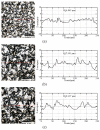Fabrication of Micro Carbon Mold for Glass-Based Micro Hole Array
- PMID: 38398923
- PMCID: PMC10890415
- DOI: 10.3390/mi15020194
Fabrication of Micro Carbon Mold for Glass-Based Micro Hole Array
Abstract
In glass molding to produce biochips with micro holes, cavities, and channels, it is important to machine micro molds. This study presents a novel process for fabricating micro pin arrays on carbon graphite, one of the glass molding materials. The micro pin array was used as a mold to fabricate a glass-based micro hole array. Using conventional micro endmill tools, machining micro-cylindrical pins requires complex toolpaths and is time-consuming. In order to machine micro pin arrays with high efficiency, a micro eccentric tool was introduced. Micro pin arrays with a diameter of 200 µm and a height of 200 µm were easily fabricated on graphite using the micro eccentric tool. In the machining of micro pin arrays using eccentric tools, the machining characteristics such as cutting force and tool wear were investigated.
Keywords: eccentric tool; glass molding; glass-based biochip; micro hole array; micro mold.
Conflict of interest statement
The authors declare no conflict of interest.
Figures
















Similar articles
-
Fabrication of a Micro-Lens Array Mold by Micro Ball End-Milling and Its Hot Embossing.Micromachines (Basel). 2018 Feb 26;9(3):96. doi: 10.3390/mi9030096. Micromachines (Basel). 2018. PMID: 30424030 Free PMC article.
-
Micro Injection Molding of Thin Cavities Using Stereolithography for Mold Fabrication.Polymers (Basel). 2021 Jun 2;13(11):1848. doi: 10.3390/polym13111848. Polymers (Basel). 2021. PMID: 34199552 Free PMC article.
-
Fabrication of Micro-Structured Polymer by Micro Injection Molding Based on Precise Micro-Ground Mold Core.Micromachines (Basel). 2019 Apr 16;10(4):253. doi: 10.3390/mi10040253. Micromachines (Basel). 2019. PMID: 30995828 Free PMC article.
-
A Comprehensive Review of Micro/Nano Precision Glass Molding Molds and Their Fabrication Methods.Micromachines (Basel). 2021 Jul 12;12(7):812. doi: 10.3390/mi12070812. Micromachines (Basel). 2021. PMID: 34357222 Free PMC article. Review.
-
Developments, challenges and future trends in advanced sustainable machining technologies for preparing array micro-holes.Nanoscale. 2024 Nov 7;16(43):19938-19969. doi: 10.1039/d4nr02910k. Nanoscale. 2024. PMID: 39403805 Review.
Cited by
-
Evolution of Holes and Cracks in Pre-Carbonized Glassy Carbon.Materials (Basel). 2024 Oct 30;17(21):5274. doi: 10.3390/ma17215274. Materials (Basel). 2024. PMID: 39517549 Free PMC article.
-
Editorial Perspective: Advancements in Microfluidics and Biochip Technologies.Micromachines (Basel). 2025 Jan 11;16(1):77. doi: 10.3390/mi16010077. Micromachines (Basel). 2025. PMID: 39858732 Free PMC article.
References
-
- Kim S.-H., Lee G.H., Park J.Y. Microwell fabrication methods and applications for cellular studies. Biomed. Eng. Lett. 2013;3:131–137. doi: 10.1007/s13534-013-0105-z. - DOI
-
- Aralekallu S., Boddula R., Singh V. Development of glass-based microfluidic devices: A review on its fabrication and biologic applications. Mater. Des. 2023;225:111517. doi: 10.1016/j.matdes.2022.111517. - DOI
-
- Hwang J., Cho Y.H., Park M.S., Kim B.H. Microchannel Fabrication on Glass Materials for Microfluidic Devices. International J. Precis. Eng. Manuf. 2019;20:479–495. doi: 10.1007/s12541-019-00103-2. - DOI
Grants and funding
LinkOut - more resources
Full Text Sources

